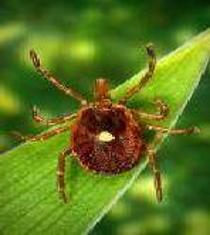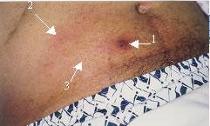It's a New Day in Public Health.
The Florida Department of Health works to protect, promote, and improve the health of all people in Florida through integrated state, county, and community efforts.
Southern Tick-Associated Rash Illness (STARI)
 Southern Tick-Associated Rash Illness (STARI) or Masters disease is a Lyme-like illness that seems to be transmitted by the Lone star tick (Amblyomma americanum), which is the most common human-biting tick in Florida. It was identified in people with a rash and other symptoms similar to those in Lyme disease that did not have evidence of infection with Borrelia burgdorferi and had been bitten by a different type of tick. A related bacterium, Borrelia lonestari has been identified and may be the cause of the illness but is not confirmed.
Southern Tick-Associated Rash Illness (STARI) or Masters disease is a Lyme-like illness that seems to be transmitted by the Lone star tick (Amblyomma americanum), which is the most common human-biting tick in Florida. It was identified in people with a rash and other symptoms similar to those in Lyme disease that did not have evidence of infection with Borrelia burgdorferi and had been bitten by a different type of tick. A related bacterium, Borrelia lonestari has been identified and may be the cause of the illness but is not confirmed.
- SYMPTOMS AND TREATMENT
- STARI OCCURRENCE IN FLORIDA
- RESOURCES

Patient with STARI;
1) site of tick bite,
2) red, radial, expanding edge of rash,
3) central clearing. Photo courtesy of CDC.
The most obvious sign of a STARI infection is a rash called erythema migrans (EM), which has the shape of a "bull's eye". This symptom is often confused with Lyme disease, which has a similar or identical rash. The rash can be seen about seven days after the tick bite, and expands outward from the site of the bite. There may be a central area of clear skin. Other signs can include tiredness, fever, headaches, muscle and joint pain. STARI differs from Lyme disease in that chronic symptoms, such as arthritis and neurological symptoms are not likely to occur. According to past and recent studies on STARI, patients recover quickly from the rash and other symptoms after treatment with oral antibiotics.
For Prevention methods view the Prevention of Tick-borne Diseases Page
STARI has been discovered in Florida and research on the occurrence of the disease is underway. A recent study has suggested that some STARI cases in the southern US may be attributable to previously undetected B. burgdorferi sensu lato. However, it may take some time before all the necessary information can be collected since much is still unknown about STARI.
*Note: This page contains materials in the Portable Document Format (PDF). The free Acrobat Reader may be required to view these files.



Connect with DOH